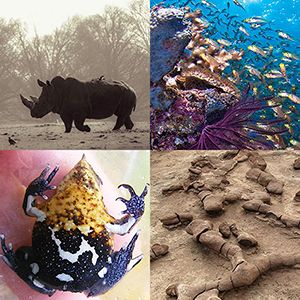The 2014 Ecological Impacts of Climate Change Collection
Post authored by Collection Curator Ben Bond-Lamberty
The impacts of climate change on global ecology, in its many forms and fields, were well represented by PLOS publications in 2013-2014. The articles chosen for the Collection were published by PLOS ONE and PLOS Biology and encompass several broad areas: experimental manipulations and observations, modeling, paleoecology, long-term studies, and support for mitigation and adaptation.
Experimental manipulation and observation are fundamental to understanding climate change impacts. For example, Anadon-Rosell et al. used a six-year soil warming experiment to examine how three dwarf shrubs may respond to high-altitude climate change, while Tair and Schiel use laboratory manipulations to study primary production and respiration in algae. Both studies point out that communities may be more severely affected than what might be expected based on the response of individual species. Such species interactions feature in a fascinating study by Pringle et al., who survey a Mesoamerican precipitation gradient and report that trees invest more in ant defenders when water is scarce; they conclude that rare but extreme herbivory events interact with water limitation to reinforce this mutualism. The interactive effects between species are studied in a theoretical setting by Northfield and Ives, who use simple models to show that coevolution can result in feedback loops that either dampen or amplify climate change effects. Modeling is also used by Riordan and Rundel in a very different arena, to examine how land use and climate change may interact in California sage scrub ecosystems across the 21st century.
 The ecological past holds many clues for the present and future. For example, paleobotanical evidence has shown rapid post-glacial movements of many tree species, faster than current observed migration rates. Feurdean et al. address this uncertainty using a macrofossil database, literature estimates, and process models to highlight the importance of microrefugia. Migration rates are partly a function of demographic processes, a subject examined by a 2014 PLOS ONE study on growth-mortality relationships in piñon pines of the U.S. southwest. Moving to the Mediterranean, Kaniewski et al. also mine the past for information, using radiocarbon, tree cores, and pollen records to reconstruct millenial changes and vulnerabilities of coastal ecosystems in northern Israel.
The ecological past holds many clues for the present and future. For example, paleobotanical evidence has shown rapid post-glacial movements of many tree species, faster than current observed migration rates. Feurdean et al. address this uncertainty using a macrofossil database, literature estimates, and process models to highlight the importance of microrefugia. Migration rates are partly a function of demographic processes, a subject examined by a 2014 PLOS ONE study on growth-mortality relationships in piñon pines of the U.S. southwest. Moving to the Mediterranean, Kaniewski et al. also mine the past for information, using radiocarbon, tree cores, and pollen records to reconstruct millenial changes and vulnerabilities of coastal ecosystems in northern Israel.
Long-term observational datasets are relatively rare and extremely valuable. A 26-year study of Magellanic penguins near Argentina found that climate change–in particular, increased rain–has lowered reproductive success in the world’s largest breeding colony of these birds. The authors conclude that similar patterns may undermine the resilience of other species in the region. The complexity of species’ responses to climate changes is emphasized by Ryan et al., who updated a 42-year-old survey of Costa Rican forest frogs. Population declines were linked with changes in temperature, rainfall, and leaf litter depth, but without any consistent pattern across the sites and species surveyed.
Møller et al. use decadal data on European birds and their parasites to examine how both hosts and parasite populations can change with climate shifts. (We humans are of course hosts as well, as Thomassen et al. emphasize in examining the predicted range shifts of human monkeypox in response to central African climate change.) Striking similar notes, Zografou et al. report on changes in butterfly communities between 1998 and 2012 in Dadia National Park, Greece, which were found to correlate with longer-term environmental change, with different patterns at high and low elevations. Butterflies and elevation effects are also the subject of Roth et al., who report significant community shifts in vascular plants, butterflies, and birds over eight years in Switzerland.
Given that a great deal of climate change is inevitable in the coming century, it is important to understand how we can mitigate and adapt to the inevitable impacts. Writing in PLOS Biology, Mora et al. provide an assessment of changes in future ocean biogeochemical variables, and the broader implications of these changes for marine biota and people. A conceptually similar study in PLOS ONE looks at climate change impacts on terrestrial vertebrate hotspots, emphasizing the threat this poses for conservation of European biodiversity. Amorim et al. examine how monitoring networks can be designed to detect potential range shifts, taking into account species’ occurrence, conservation status, and unpredictable volunteer commitment. Finally, Rout et al. ask how we decide to move species threated by climate change, applying a qualitative decision framework to the case study of tuatara, a New Zealand reptile.
As I wrote a year ago, the broad range of these papers emphasize both the multi-faceted impacts of climate change on natural and human systems, as well as the breadth and depth of research on these subjects being published in PLOS journals.
Dr. Bond-Lamberty is a Research Scientist at the Joint Global Change Research Institute, a partnership of the Pacific Northwest National Laboratory (PNNL) and the University of Maryland, College Park. His research focuses on carbon cycling in terrestrial ecosystems, particularly boreal and other northern forests, and their response to natural and human-initiated disturbances. He has extensive experience modeling biogeochemical cycling in these systems, as well as in manipulative field and lab experiments. He also acts as a Section Editor for PLOS ONE.
